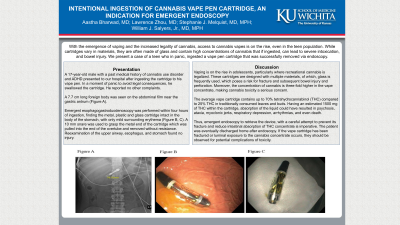Tuesday Poster Session
Category: General Endoscopy
P3440 - Intentional Ingestion of Cannabis Vape Pen Cartridge: An Indication for Emergent Endoscopy
Tuesday, October 24, 2023
10:30 AM - 4:00 PM PT
Location: Exhibit Hall

Has Audio

Aastha V. Bharwad, MD
University of Kansas School of Medicine
Wichita, KS
Presenting Author(s)
Aastha Bharwad, MD, Lawrence Zhou, MD, Stephanie J. Melquist, MD, MPH, William J.. Salyers, MD, MPH
University of Kansas School of Medicine, Wichita, KS
Introduction: With the emergence of vaping and increased legality of cannabis, access to cannabis vapes is on the rise, even in the teen population. While cartridges vary in materials, they are often made of glass and contain high concentrations of cannabis that if ingested, can lead to severe intoxication, and bowel injury. We present a case of a teen who in panic, ingested a vape pen cartridge that was successfully removed via endoscopy.
Case Description/Methods: A 17-year-old male with cannabis abuse disorder and ADHD presented to our emergency room after ingesting the cartridge to his vape pen. In a moment of panic to avoid legal consequences, he swallowed the cartridge. He had no other complaints. A 7.7 cm long foreign body was seen on abdominal film near the gastric antrum (Figure A). Emergent esophagogastroduodenoscopy was performed within four hours of ingestion, finding the metal, plastic and glass cartridge intact in the body of the stomach, with only mild surrounding erythema (Figure B, C). A 10 mm snare was used to grasp the metal end of the cartridge which was pulled into the end of the overtube and removed without resistance. Reexamination of the upper airway, esophagus and stomach found no injury.
Discussion: Vaping is on the rise in adolescents, particularly where recreational cannabis is legalized. Few cases of cartridge ingestion have been described. These cartridges are designed with multiple materials, of which, glass is frequently used, which poses a risk for fracture and subsequent bowel injury and perforation. Moreover, the concentration of cannabis is three-fold higher in the vape concentrate, making cannabis toxicity a serious concern. The average vape cartridge contains up to 70% tetrahydrocannabinol (THC) compared to 25% THC in traditionally consumed leaves and buds. Having an estimated 1500 mg of THC within the cartridge, absorption of the liquid could have resulted in psychosis, ataxia, myoclonic jerks, respiratory depression, arrhythmias, and even death. Thus, emergent endoscopy to retrieve the device, with careful attempt to prevent its fracture and reduce intestinal absorption of THC concentrate is imperative. This person was discharged home after endoscopy. If the vape cartridge has been fractured or luminal exposure to the cannabis concentrate occurs, they should be observed for potential complications of toxicity.

Disclosures:
Aastha Bharwad, MD, Lawrence Zhou, MD, Stephanie J. Melquist, MD, MPH, William J.. Salyers, MD, MPH. P3440 - Intentional Ingestion of Cannabis Vape Pen Cartridge: An Indication for Emergent Endoscopy, ACG 2023 Annual Scientific Meeting Abstracts. Vancouver, BC, Canada: American College of Gastroenterology.
University of Kansas School of Medicine, Wichita, KS
Introduction: With the emergence of vaping and increased legality of cannabis, access to cannabis vapes is on the rise, even in the teen population. While cartridges vary in materials, they are often made of glass and contain high concentrations of cannabis that if ingested, can lead to severe intoxication, and bowel injury. We present a case of a teen who in panic, ingested a vape pen cartridge that was successfully removed via endoscopy.
Case Description/Methods: A 17-year-old male with cannabis abuse disorder and ADHD presented to our emergency room after ingesting the cartridge to his vape pen. In a moment of panic to avoid legal consequences, he swallowed the cartridge. He had no other complaints. A 7.7 cm long foreign body was seen on abdominal film near the gastric antrum (Figure A). Emergent esophagogastroduodenoscopy was performed within four hours of ingestion, finding the metal, plastic and glass cartridge intact in the body of the stomach, with only mild surrounding erythema (Figure B, C). A 10 mm snare was used to grasp the metal end of the cartridge which was pulled into the end of the overtube and removed without resistance. Reexamination of the upper airway, esophagus and stomach found no injury.
Discussion: Vaping is on the rise in adolescents, particularly where recreational cannabis is legalized. Few cases of cartridge ingestion have been described. These cartridges are designed with multiple materials, of which, glass is frequently used, which poses a risk for fracture and subsequent bowel injury and perforation. Moreover, the concentration of cannabis is three-fold higher in the vape concentrate, making cannabis toxicity a serious concern. The average vape cartridge contains up to 70% tetrahydrocannabinol (THC) compared to 25% THC in traditionally consumed leaves and buds. Having an estimated 1500 mg of THC within the cartridge, absorption of the liquid could have resulted in psychosis, ataxia, myoclonic jerks, respiratory depression, arrhythmias, and even death. Thus, emergent endoscopy to retrieve the device, with careful attempt to prevent its fracture and reduce intestinal absorption of THC concentrate is imperative. This person was discharged home after endoscopy. If the vape cartridge has been fractured or luminal exposure to the cannabis concentrate occurs, they should be observed for potential complications of toxicity.

Figure: Figure A: 7.7 cm long foreign body on abdominal film near the gastric antrum
Figure B: Intact cartridge in the body of the stomach with mild surrounding erythema seen on esophagogastroduodenoscopy
Figure C: Removed intact cartridge
Figure B: Intact cartridge in the body of the stomach with mild surrounding erythema seen on esophagogastroduodenoscopy
Figure C: Removed intact cartridge
Disclosures:
Aastha Bharwad indicated no relevant financial relationships.
Lawrence Zhou indicated no relevant financial relationships.
Stephanie Melquist indicated no relevant financial relationships.
William Salyers indicated no relevant financial relationships.
Aastha Bharwad, MD, Lawrence Zhou, MD, Stephanie J. Melquist, MD, MPH, William J.. Salyers, MD, MPH. P3440 - Intentional Ingestion of Cannabis Vape Pen Cartridge: An Indication for Emergent Endoscopy, ACG 2023 Annual Scientific Meeting Abstracts. Vancouver, BC, Canada: American College of Gastroenterology.
